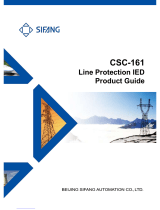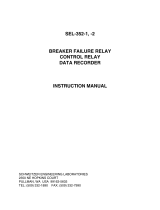
The main purpose of the OOSPPAM function is to detect,
evaluate, and take the required action during pole slipping
occurrences in the power system.
The OOSPPAM function detects pole slip conditions and trips
the generator as fast as possible, after the first pole-slip if the
center of oscillation is found to be in zone 1, which normally
includes the generator and its step-up power transformer. If
the center of oscillation is found to be further out in the power
system, in zone 2, more than one pole-slip is usually allowed
before the generator-transformer unit is disconnected. A
parameter setting is available to take into account the circuit
breaker opening time. If there are several out-of-step relays in
the power system, then the one which finds the center of
oscillation in its zone 1 should operate first.
Two current channels I3P1 and I3P2 are available in
OOSPPAM function to allow the direct connection of two
groups of three-phase currents; that may be needed for very
powerful generators, with stator windings split into two
groups per phase, when each group is equipped with current
transformers. The protection function performs a simple
summation of the currents of the two channels I3P1 and
I3P2.
Phase preference logic PPL2PHIZ
GUID-39785DEB-E5D7-447C-977B-9E940CA8E774 v1
The Phase preference logic function (PPL2PHIZ) is used with
the high speed distance protection, quad and mho
characteristic (ZMFPDIS). It is intended to be used in isolated
or high impedance earthed networks where there is a
requirement to operate on only one of the faulty lines during a
cross-country fault. It can be used without preference to
restrain operation for single earth faults with a delayed zero-
sequence current release.
For cross-country faults, the logic selects either the leading or
lagging phase-earth loop for measurement. It initiates
operation on the preferred fault based on the selected phase
preference. A number of different phase preference
combinations are available for selection.
PPL2PHIZ provides an additional phase selection criteria,
namely under voltage criteria, suitable for cross-country
faults. In radial networks, where there is no fault current in the
phase with the external fault, current or impedance based
phase selection methods become ineffective. Hence, only
voltage can be used for phase selection. The phase selection
result will be the same for all bays on a bus since the voltage
is the same, which is an important condition for operating
with phase preference.
In meshed and stronger networks, it is difficult to find
appropriate under-voltage or phase selection settings. If
PPL2PHIZ is unable to detect both faulty phases, then it is
not possible to provide preference. The distance protection
will still be released however, without preference. The final
result might be that both faulty feeders are operated. In other
words, operation is prioritized over strict adherence to
preference.
Automatic switch onto fault logic, voltage and current based
ZCVPSOF
M13829-3 v4
Automatic switch onto fault logic (ZCVPSOF) is a function that
gives an instantaneous trip at closing of breaker onto a fault.
A dead line detection check is provided to activate the
function when the line is dead.
4. Current protection
Instantaneous phase overcurrent protection PHPIOC
M12910-3 v13
The instantaneous three phase overcurrent function has a low
transient overreach and short tripping time to allow use as a
high set short-circuit protection function.
Directional phase overcurrent protection, four steps
OC4PTOC
M12846-3 v17
Directional phase overcurrent protection, four steps
(OC4PTOC) has an inverse or definite time delay for each
step.
All IEC and ANSI inverse time characteristics are available
together with an optional user defined time characteristic.
The directional function needs voltage as it is voltage
polarized with memory. The function can be set to be
directional or non-directional independently for each of the
steps.
A second harmonic blocking level can be set for the function
and can be used to block each step individually.
Instantaneous residual overcurrent protection EFPIOC
M12701-3 v16
The Instantaneous residual overcurrent protection (EFPIOC)
has a low transient overreach and short tripping times to
allow the use for instantaneous earth-fault protection, with the
reach limited to less than the typical eighty percent of the line
at minimum source impedance. EFPIOC is configured to
measure the residual current from the three-phase current
inputs and can be configured to measure the current from a
separate current input.
Directional residual overcurrent protection, four steps
EF4PTOC
M13667-3 v19
Directional residual overcurrent protection, four steps
(EF4PTOC) can be used as main protection for phase-to-
earth faults. It can also be used to provide a system back-up,
for example, in the case of the primary protection being out of
service due to communication or voltage transformer circuit
failure.
EF4PTOC has an inverse or definite time delay independent
for each step.
All IEC and ANSI time-delayed characteristics are available
together with an optional user-defined characteristic.
1MRK 506 384-BEN A
Line distance protection REL650 2.2
Product version: 2.2.1
16 ABB





















